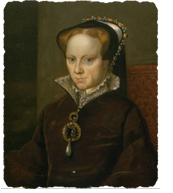

Mary Tudor was born on the 18 February 1516 at Greenwich Palace. Mary became Queen in 1553 aged thirty-seven. Her father was King Henry VIII and her mother Catherine of Aragon, a devout Roman Catholic. One of Mary’s first acts was to declare her parents marriage valid once more.
Mary was crowned Queen at Westminster Abbey on the 1 October 1553 in a magnificent ceremony. The coronation ceremony followed many of the same rituals as those of previous Kings of England. Mary was crowned wearing crimson robes. She received the sword, orb, spurs and sceptre that represented the powers of Kingship. Mary was anointed with holy oil, although she had consecrated oil sent from Catholic Flanders as Mary refused to use the ‘tainted’ oil that had anointed the Protestant Edward. The Archbishop of Winchester Stephen Gardiner performed the ceremony rather than the Archbishop of Canterbury. Thomas Cranmer who had been imprisoned in the Tower for supporting Lady Jane Grey.
Mary chose as her personal motto, Veritas Temporis Filia, Truth the Daughter of Time.
One of Mary’s first tasks as Queen was to establish a Council. While some of her trusted household servants were given positions in her government, Mary also chose to retain some of Edward’s councillors. Despite them having previously supported the attempt to place Lady Jane Grey on the throne, Mary valued their experience in running the country. The Archbishop of Winchester Stephen Gardiner, who had spent most of Edward’s reign in the Tower, was appointed Lord Chancellor.
Mary was England’s first crowned Queen Regnant that is a Queen who rules in her own right and not just through marriage to a King. At this time it was generally believed that women were unfit to rule. The radical Protestant reformer John Knox argued in First Blast of the Trumpet against the Monstrous Regiment of Women (1558) that a female Monarch went against the teachings of the Bible. Mary had to overcome the prejudices of her government and people and prove that a woman was capable of ruling England.
One of the first pieces of legislation passed by Parliament was to formally state that the marriage between Henry VIII and Catherine of Aragon was legal and valid. This meant that legally Mary was no longer illegitimate.
Parliament was most concerned with the issue of Mary’s marriage. They assumed that Mary would marry and it was generally thought that she would need a husband to help her govern successfully. However, women were expected to be dutiful wives and obey their husbands. Upon marriage a husband also acquired all of his wife’s property and titles. England had no legal precedent for the marriage of a reigning female Monarch.
Continue reading with these recommended books (paid links)
The Terrible Tudors: Misery Mary (The Horrible Histories Collection)
 |
 |
 |
